The Rosewill Photon 1050W Review
by E. Fylladitakis on March 24, 2015 8:00 AM EST- Posted in
- Cases/Cooling/PSUs
- Rosewill
- 1050W
- Sirfa
Hot Test Results
By the results presented in the following tables, the Rosewill Photon 1050W offers good power quality, especially considering the temperatures that the components reached inside our hotbox. The maximum ripple on the 12V line was 56mV under full load, a fair figure considering that this is a unit rated for operation at 40°C. The 3.3V/5V voltage lines fared better, with the maximum ripple being 22mV/24mV respectively. Voltage regulation is very good, at just 1.2% for the 12V line and about 1.6% for the minor lines.
| Main Output | ||||||||
| Load (Watts) | 212.08 W | 528.3 W | 788.6 W | 1047.54 W | ||||
| Load (Percent) | 20.2% | 50.31% | 75.1% | 99.77% | ||||
| Line | Amperes | Volts | Amperes | Volts | Amperes | Volts | Amperes | Volts |
| 3.3 V | 4.17 | 3.37 | 10.44 | 3.35 | 15.66 | 3.33 | 20.87 | 3.31 |
| 5 V | 4.17 | 5.13 | 10.44 | 5.09 | 15.66 | 5.07 | 20.87 | 5.05 |
| 12 V | 14.61 | 12.09 | 36.53 | 12.05 | 54.8 | 11.99 | 73.06 | 11.95 |
| Line | Regulation (20% to 100% load) |
Voltage Ripple (mV) | |||||
| 20% Load | 50% Load | 75% Load | 100% Load | CL1 12V |
CL2 3.3V + 5V |
||
| 3.3V | 1.6% | 8 | 12 | 18 | 22 | 12 | 26 |
| 5V | 1.55% | 10 | 16 | 22 | 24 | 16 | 26 |
| 12V | 1.2% | 20 | 32 | 44 | 56 | 54 | 20 |
Once again, we need to mention that this is a PSU rated at 40°C and we perform our testing at temperatures higher than 45°C - we could reduce the ambient temperature of our hotbox testing but we chose not to do so as the results would then not be comparable to those of our previous reviews.
The high ambient temperatures have a significant impact on the electrical performance of the Photon 1050W, reducing its energy conversion efficiency by an average of 2%. The drop is higher as the load increases, reaching a massive 3.7% drop with a load of 1050W. Considering that the ambient temperature is almost 48°C at this point, these actually are overload conditions for the Photon, meaning that its capability to maintain good power quality and keep operating with such a load is a victory all by itself.
By looking at the internal temperatures of the Photon 1050W, one can easily realize who the culprit behind the dropping efficiency is. This is one of the hottest PSUs we have ever tested. With the temperature of the secondary side heatsink surpassing 100°C under maximum load and the primary side heatsink following closely, it is easy for anyone with basic electronics knowledge to deduct that the exceedingly high temperatures at the very least increase the resistance of the components. The cooling fan is now audible even at low loads, with its speed constantly increasing to keep up with the increasing energy losses. Even though it jumps at maximum speed when the load is about 900 Watts, it cannot stay ahead of the curve with the heavy energy losses.


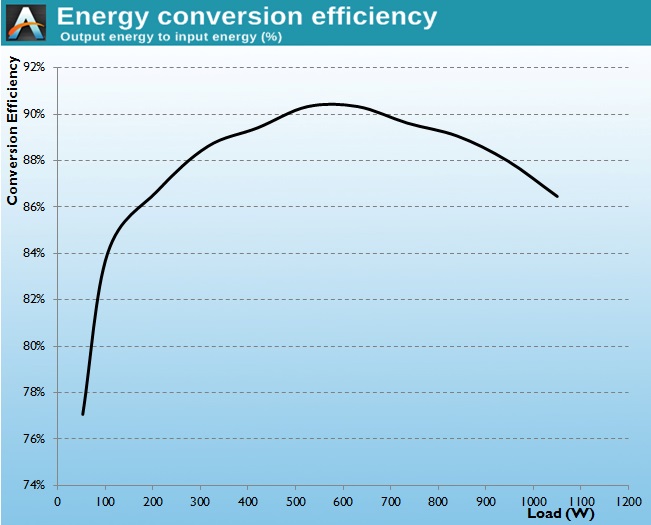
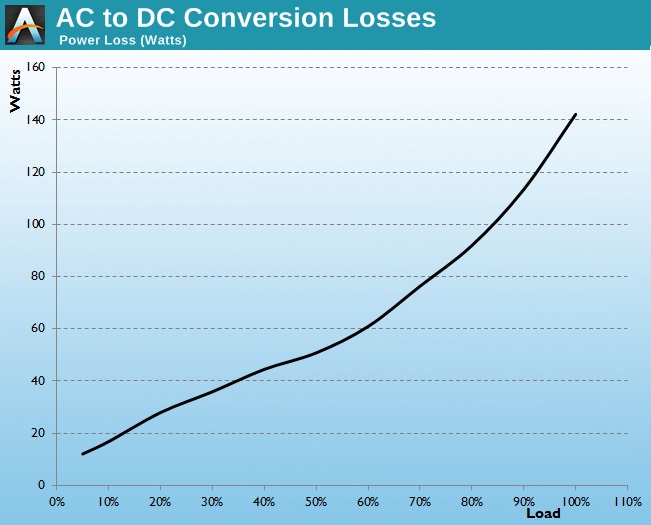
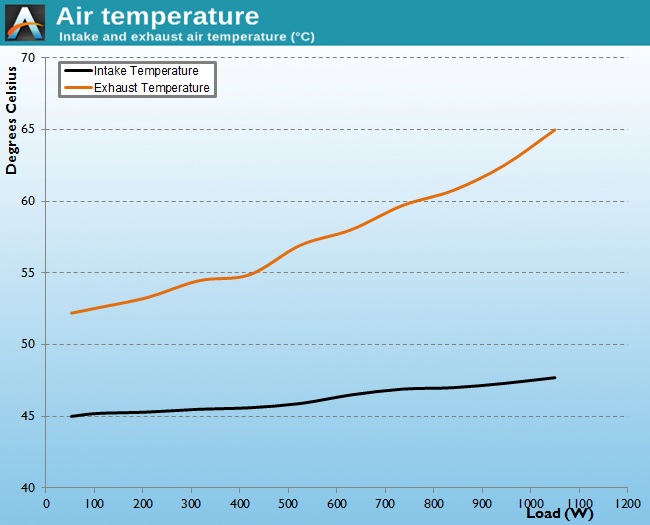
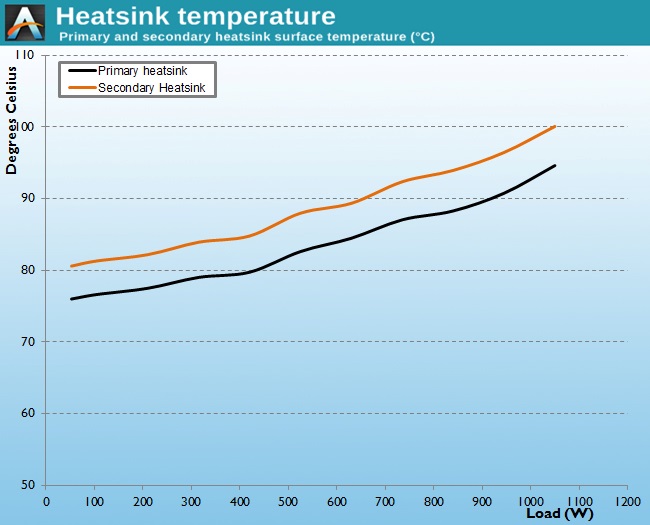
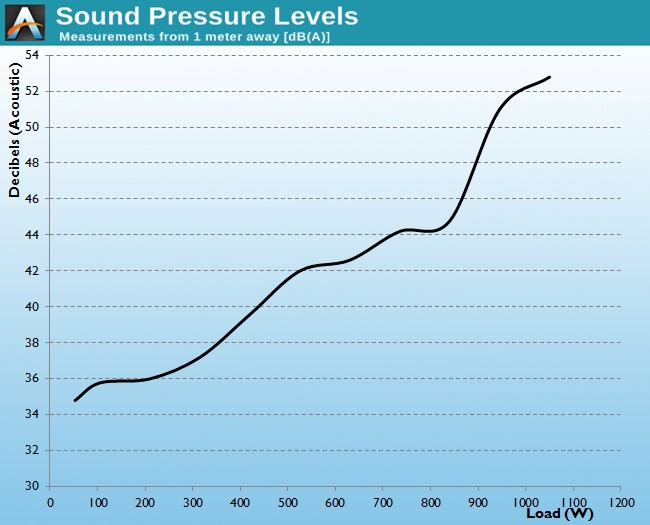








42 Comments
View All Comments
DanNeely - Tuesday, March 24, 2015 - link
Yup. And while I know loaned/donated hardware is the default for most reviews; in a roundup review, spending $30-60 for a single no-name model to show what spending a little more for a brand name model gives should be an acceptable use of editorial dollars. Two cheap models might be worth it as well; one obvious garbage box to be sacrificed on the alter of magic smoke, and a second that while expected to survive is a few steps down on the performance scale (eg bare 80plus). I wonder if you might be able to fiangle the latter out of one of the OEMs: "I want a baseline model to demonstrate why your 80+ gold model is worth the extra $20."chlamchowder - Wednesday, March 25, 2015 - link
If I may add one more thing, I have never once looked at a 1000W power supply and said "this unit performs well, so this brand's 400-600W units must be good too".When I went shopping for a PSU, I went for a $40 500W model with a plain 80+ rating because there were practically no reviews of sub-$100 400-600W units (and I didn't want a $20 no-name model that might have 45% efficiency). But if reviews showed that spending $100 gave a big improvement over lower priced units, I might have decided differently.
DanNeely - Tuesday, March 24, 2015 - link
The other half is that high efficiency PSUs only pay for themselves under largish 24/7 loads at typical US power prices. I played around with the numbers recently for my new build:For a 24/7 load (distributed computing), $0.12/kwh for electricity, modular designs only, and wanting ~200W headroom to keep the PSU fan from adding to the system noise; and over 6 years a 91% platinum PSU only broke even over an 88% gold unit if I ran SLI/xFire for about half the time. In a pure single GPU config the gold model barely broke even vs a cheaper silver model. I ended up going with the platinum model because I expect the 5k monitor I'm planning on buying in the next 12-24 months almost certainly will require SLI/xFire for a few years; combined with a housing situation where my landlord is responsible for the heating bill while air conditioning is on me tipping the scale.If your PC spends most of its day off/idle a high efficiency PSU isn't going to give much of a return except possibly at very high electricity rates. If an OEM ever makes one, a small 80+ titanium unit might be worthwhile for mainstream users just due to the large boost it requires at a 10% load.
JeffFlanagan - Tuesday, March 24, 2015 - link
Good point. Power requirements for PCs with massive storage have also come down quite a bit now that 3 2TB drives can be replaced with a single 6TB drive.bigboxes - Tuesday, March 24, 2015 - link
I have 8 hard drives (1 SDD for the OS) in my file server. If they increase the size I'll just get 8 6TB drives. Right now I'm slowly migrating to 4TB models (up from 1.5TB and 2TB models). Hard drives don't consume a lot of energy regardless.Gigaplex - Tuesday, March 24, 2015 - link
My home server has 5 hard drives (4x 3TB array plus the OS drive) and i'm using a 450W PSU. The system idles at 60W measured at the wall. It hits about 75W when the array is maxing out the gigabit network connection. The only time you really need to worry about power requirements for "massive storage" is during boot, but if you stagger the spin-up then it's not a problem. Not that I've had to bother with my current system.romrunning - Tuesday, March 24, 2015 - link
"The high ambient temperatures have a significant impact on the electrical performance of the Photon 1050W, reducing its energy conversion efficiency by an average of 2%. The drop is higher as the load increases, reaching a massive 3.7% drop with a load of 1050W."C'mon now, an increase from 2% to 3.7% is NOT a "massive" difference.
SirGCal - Tuesday, March 24, 2015 - link
You wouldn't be saying that if it was the APR % difference in your mortgage for example... If you were at 2% and they raised you to 3.7%, you'd @#$% the bed. Everything is perspective.romrunning - Tuesday, March 24, 2015 - link
C'mon now, don't conflate two items that are completely different. Changes in a mortgage APR don't equally equate into slight changes in a power supply's energy conversion efficiency.If two power supplies were being compared and one was 3.7% while the other was 5.0%, would you still describe the 3.7% variance as "massive"? How would you describe the 5.0% variance?
E.Fyll did a good job with his review; I just thought the word "massive" was a bit hyperbolic in the context used.
E.Fyll - Tuesday, March 24, 2015 - link
Actually, it is an 85% increase over the average efficiency drop. That, alongside the fact that everything above 1-1.5% for that particular test is very high, is pretty much massive.